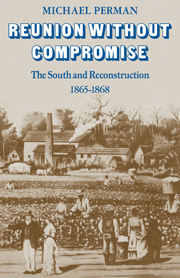Book contents
- Frontmatter
- Contents
- Preface
- Part I Conciliation and conflict
- Part 2 Encouraging Southern loyalty, 1865
- 2 The Provisional Governors
- 3 Strategies for readmission
- 4 Discretion decentralized
- 5 Misrepresentation
- Part 3 Seeking Southern cooperation, 1866
- Part 4 Demanding Southern acquiescence, 1867–1868
- Epilogue: The irrelevance of the moderates, 1865–1868
- Appendix: Registration and voting statistics for the Southern State Constitutional Conventions, 1867–8
- A note on sources
- Index
4 - Discretion decentralized
Published online by Cambridge University Press: 05 August 2012
- Frontmatter
- Contents
- Preface
- Part I Conciliation and conflict
- Part 2 Encouraging Southern loyalty, 1865
- 2 The Provisional Governors
- 3 Strategies for readmission
- 4 Discretion decentralized
- 5 Misrepresentation
- Part 3 Seeking Southern cooperation, 1866
- Part 4 Demanding Southern acquiescence, 1867–1868
- Epilogue: The irrelevance of the moderates, 1865–1868
- Appendix: Registration and voting statistics for the Southern State Constitutional Conventions, 1867–8
- A note on sources
- Index
Summary
The mechanics of Provisional Government were central to the problem of reunion and restoration. The fashion in which the South was governed while under the direct control of the civil and military power of the United States was probably more important than the details of the formal terms offered by the President. After all, the conventions and legislatures which were called upon to consider the President's stipulations were to be elected from a society which had been organized and governed by Washington and its local agents, the Provisional Governors.
Rather than retain the South under direct military control, the President chose to restore self-government. But it was a ‘self-government’ so regulated and restricted that Southern politicians could assert simultaneously that their State was sovereign and also that its action was substantially limited both by military occupation and the power of Northern politicians and officials. These same anomalous circumstances ensured that the role and power of the Provisional Governor would also be ambiguous, even confused.
The men who were selected by the President to reorganize Southern governments were endowed with powers more extensive than State Governors enjoyed under normal conditions. David L. Swain noted with exaggeration that ‘the Governor is in the full exercise of powers, not merely greater than known to any of his predecessors, but greater than ever were claimed for an English monarch since 1688.’ The power of the Provisional Governor was in fact great, even if not as wide as Swain claimed.
- Type
- Chapter
- Information
- Reunion Without CompromiseThe South and Reconstruction: 1865–1868, pp. 110 - 143Publisher: Cambridge University PressPrint publication year: 1973
- 1
- Cited by

